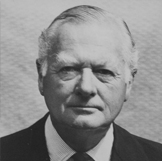Sir Richard Vassar-Smith

Sir Richard Vassar-Smith (‘Sir Rich’)
The fourth Headmaster (1957-71)
Richard Rathborne Vassar–Smith was born in India in 1909, the only son of Major Charles Vassar-Smith. As an infant, he survived an early encounter with a snake while sitting in the garden, thanks to the heroism of the family mongoose.
In 1918, he was sent to Saint Ronan’s but, sadly, his father died in 1920 when Sir Richard was just an eleven years old. At Saint Ronan’s he began to show some talent on the sports field, while possessing ‘a good mind’, as one of his reports suggested.
In 1921, he went onto Lancing (WBH was his housemaster for three years). At Lancing, his footballing skill became more apparent and he played in, and then captained, the school First Eleven, attracting the notice of the Corinthians, who made some of their first trips to the college to play the team in these years.
Lancing was followed by Cambridge and Sir Richard went up to Pembroke College to read Divinity, benefiting from the St. Ronan’s Scholarship to the college, which had been set up in memory of the second headmaster, Stanley Harris, who died in 1927. Sir Richard played for the Varsity XI for three years and was secretary in his final year, although on this occasion he played only a small part in the mach against Oxford having, as he noted in his dairy, an ankle injury on which he could ‘hardly walk, let alone run’. In addition to the university team, he also turned out as left midfield for the Corinthian Club (later the Corinthian Casuals).
His mother (always known to the school as simply ‘Mrs Vas’) joined the staff in 1923, taking over the domestic side of school life from Mrs Murray and thus providing ‘feminine warmth’ in a bachelor-dominated environment. She served the school until 1948 and thus travelled with the school from West Worthing to Bicton Park in Devon (1940-45) and then on to Hawkhurst (1945- ).
After coming down from Cambridge in 1932, Sir Richard joined Lloyds Bank, where his grandfather, the first baronet, had been chairman. He married Mary Dawn Woods in the same year. Five years of banking was, however, enough for him to realise his interests lay elsewhere, despite the fact that he found time around the job to turn out for the Bank football team (as a forward) and the Lancing old boys! He left the bank in 1937 and became a school master in a London Prep school before being drawn into the war.
In 1939 he was commissioned into the Royal Artillery, becoming a major in 1943. He was sent to Anti-Aircraft Command and eventually given charge of a battery in the Isle of Dogs. This was one of the early mixed batteries, including girls from the Auxiliary Territorial Service (ATS), which aimed its guns at the Luftwaffe – and in due course at Hitler’s VI ‘Doodlebug’ missiles, which droned over London’s suburbs from their launch pads across the Channel. It was the locations of the gun stations across central London that were later used to name the dormitories in Tongswood.
Following demobilisation in 1946, he moved to his old school, Saint Ronan’s. Soon after this he became W B Harris’s junior partner. To begin with he taught English and Latin grammar, later adding Divinity to his repertoire.
In August 1957, WB Harris died. In his will, he bequeathed his share of the school to Sir Richard but placed the estate in trust. For some time this led to the curious situation of the headmaster leasing the school from himself (as one of the trustees of the WB Harris Trust). It was said that he felt most at home on the sports field of Saint Ronan’s where, according to The Times, he turned himself into a ‘first class coach’. During the holidays, supporting KCC and playing golf at Rye were serious preoccupations, as was the construction, with his son and daughter, of various kit cars whose presence outside the Queen’s Head (where at one stage the family lived while school accommodation was being sorted out) became a byword.
In April 1971, Sir Richard transferred the Headmastership to his son, Johnny, whilst his daughter, Juliet, assumed Lady Vas’s responsibilities. Both Sir Richard and Lady Vas continued to be intractably involved in the life of the school for the rest of their lives, living in Orchard House until 1992 and attending matches, or in Lady Vas’s case, sitting with the boys in the afternoon in the eponymous classroom.
Sir Richard died in 1995. Lady Vas died six years later.
